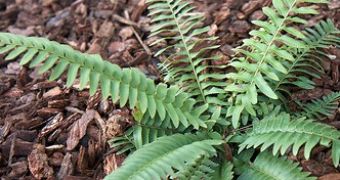Climate change affects not only global temperatures and water cycling but also animals and plants worldwide. In a recent study published in the July issue of the American Journal of Botany, Dr Emily Limm and DrTodd Dawson from the University of California, revealed how it also affects plants that get their water from fog.
Fog is a water resource during the dry period of the year. As nowadays dryness tends to generalize, fog is the last chance of hydration for several plants. Whether it condenses and drips to soil or it stays in its natural form, plants can absorb water from fog through their roots or their leaves. In the redwood forests in northern California, the forest floor is almost entirely covered in the Polystichum munitum fern. As this plant gets its water through its leaves, the two scientists studied the way that the fern size affects its ability to hydrate.
The Polystichum munitum fern is affected by the growing and persistent heat in the south of the redwood forest, where it starts to develop less than usually. As the “summertime drought conditions are higher in the south of the redwood forest ecosystem of Northern California ... this reduces Polystichum munitum abundance and plant size. These smaller ferns in the south are less able to capture fog water that drips to the forest floor during the summer, and they may therefore suffer more drought stress than ferns in the northern end of the redwood forest ecosystem," Limm said.
If the fern does not acclimate to growing heat and drought conditions this might affect the redwood's ecosystem, and other plant populations might soon be extinct. Scientists can only hope that this will not occur and they keep observing the plant's evolution.
Meanwhile, Limm and Dawson have involved others in their research, thanks to the Citizen Scientist program. People collected data on the affluence of the Polystichum munitum fern in a redwood near Oakland. This action helped research on the effect of climate change on the fern and apparently changed the public perception on the forest.
“I've often heard people exclaim that they never realized that there where even plants on the forest floor in the redwood forest because they are always looking up at the giant coast redwoods…After they learn about P. munitum's amazing ability to absorb fog water through their leaves in much higher rates than the coast redwood, they often tell me that they will never look at a fern the same way again,” Limm stated.

 14 DAY TRIAL //
14 DAY TRIAL //